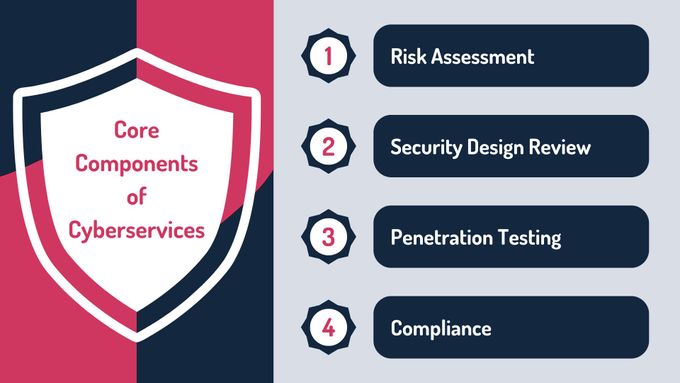What Does "Cyberservices" Really Mean?
Discover what cyberservices entail, including their role in achieving cybersecurity through actionable strategies like risk assessment and compliance management. Learn how GRSee’s tailored solutions safeguard businesses against evolving cyber threats.
Published April 5, 2025.

In 2023, the cost of a data breach reached an all-time high, with an average of $4.45 million globally, according to IBM’s latest Data Breach Report. These staggering numbers emphasize that it’s no longer just large corporations at risk—organizations of all sizes must contend with growing cyber threats. Beyond financial damages, businesses face operational downtime, loss of customer trust, and reputational harm.
To combat these risks, cyberservices have emerged as a solution for building robust defenses and maintaining operational integrity. In this article, we'll break down what cyberservices entail, how they align with cybersecurity principles, and the core components that make them essential for modern businesses.
» Set a FREE session with our experts for all-in-one cyberservices
Cyberservices vs. Cybersecurity
| Category | Cyberservices | Cybersecurity |
|---|---|---|
| Definition | Actionable services that implement security measures. | The state of being protected against cyber threats. |
| Focus | Tools, strategies, and processes for achieving security. | Protecting systems, networks, and data. |
| Components | Includes risk assessment, penetration testing, compliance support, etc. | Encompasses broad principles like confidentiality, integrity, and availability (the CIA triad). |
| End Goal | Provides the steps to achieve cybersecurity. | Maintains a secure digital environment. |
What Is Cybersecurity?
Cybersecurity refers to the practices, technologies, and strategies used to protect networks, devices, and data from cyber threats.
It focuses on the principles of confidentiality, integrity, and availability, ensuring that sensitive information is safe from unauthorized access and tampering. Cybersecurity is the ultimate goal of cyberservices.
Typical cybersecurity threats faced by businesses include:
- Hacking: Hacking involves gaining unauthorized access to computer systems or networks. Hackers may exploit vulnerabilities in software, networks, or human behavior to gain access to sensitive information, disrupt operations, or extort money
- Phishing: Phishing is a type of cyberattack where attackers impersonate legitimate entities, such as banks or trusted organizations, to deceive individuals into revealing sensitive information, such as passwords, credit card numbers, or social security numbers.
- Malware: Malware refers to malicious software designed to harm computer systems or steal data. These include viruses, worms, trojans, and ransomware.
- Denial-of-service (DDoS) attacks: Overwhelming a system or network with traffic to prevent legitimate users from accessing it.
» Here are the ways malware can bypass endpoint protection
What Are Cyberservices?
Cyberservices are the actionable processes and tools that enable businesses to achieve cybersecurity.
They include a range of specialized services designed to assess risks, identify vulnerabilities, and implement defenses. Unlike the broader concept of cybersecurity, cyberservices provide a structured pathway to protect your systems and networks effectively.
The actionable benefits of cyberservices and cybersecurity include:
- Increased privacy and security: Cybersecurity technologies protect networks, data, and apps from unauthorized access. Cybersecurity also protects against attacks that can steal or compromise data, ensuring that only authorized individuals will access sensitive information.
- Improved brand reputation: Ensuring that your business is compliant with regulations and maintains a strong cybersecurity framework can help instill trust in stakeholders and potential customers.
- Cost efficiency: Tackling cybersecurity on time ensures that you can mitigate potential future attacks, leading to long-term cost savings as you have to invest less in damage control and remediating breaches.
Examples of Cyberservices
Managed cyberservices encompass a variety of specialized offerings tailored to meet specific security needs. For instance:
- Risk assessment helps businesses identify potential threats to their digital assets
- Penetration testing simulates real-world attacks to uncover system vulnerabilities
- Security design reviews ensure the architecture aligns with security standards
- Compliance management helps organizations adhere to regulatory requirements like GDPR or PCI DSS
Core Components of Cyberservices
Each cyberservice plays a vital role in building and maintaining cybersecurity. Here’s a breakdown of the core components:
1. Risk Assessment
Risk assessment is the backbone of cyberservices. It identifies potential threats and vulnerabilities in your systems. This foundational step allows experts to develop targeted strategies to mitigate risks and strengthen defenses.
» Discover what's involved in the risk assessment process
2. Security Design Review
Staying safe isn’t only about guessing what hackers might attempt and closing those holes, it’s about reviewing the very structure of your applications and networks to guarantee that they meet a certain standard of security. The architecture of your systems is studied on a broad level and then much deeper, reviewing the security layers of each component.
Ideally, a security design review should be performed before the official launch or release of an app to try and ensure security before anyone has the opportunity to take advantage of a vulnerability.
3. Penetration Testing (PT)
Penetration testing in cybersecurity mimics the actions of cybercriminals to expose weaknesses in your networks and applications. Pentesting experts simulate attacks to uncover vulnerabilities, providing actionable insights to improve your security posture.
Penetration testing can usually catch anything that was missed or overlooked in the security design review.
4. Compliance
Adhering to regulatory and industry standards is crucial for legal and operational reasons. National and regional governments often implement detailed regulations on a business's cyber activities to protect consumers and support fair practices.
Cyberservices help businesses navigate complex compliance requirements, protecting both assets and reputation.
Other Technical Services
Managed cyberservices can also include:
- Advanced persistent threat (APT) simulations: An APT is a sophisticated, long-lasting cyberattack carried out by a highly skilled and well-resourced attacker, often a nation-state or a highly organized criminal group. The goal of an APT is to gain unauthorized access to a target system, steal sensitive information, and maintain persistent access over an extended period.
- Code review: A process where developers examine each other's code to identify and fix errors, vulnerabilities, and security weaknesses. It's a crucial step in the software development process to improve code quality and security.
- Secure development lifecycle (SDLC) assessments: A framework that integrates security practices into every stage of software development, from planning and design to deployment and maintenance.
- Firewall rulebase review: A firewall rulebase is a set of rules that determine what traffic is allowed to pass through a firewall. A firewall rulebase review involves examining these rules to ensure they are accurate, up-to-date, and effective in protecting the network.
- System (Win/Linux) hardening and vulnerability scans: System hardening is the process of securing a computer system by configuring its settings to minimize vulnerabilities and strengthen its defenses against attacks. This involves disabling unnecessary services, applying security patches, using strong passwords, and implementing other security measures.
- CISO-as-a-service: A cybersecurity service model where organizations outsource their Chief Information Security Officer (CISO) functions to a third-party provider. This allows organizations to access CISO-level expertise and guidance virtually (vCISO) without the need to hire a full-time CISO.
» Need help? Here's how to engage with a CISO
Understanding the Cyberservice Philosophy
Cyberservices empower organizations to stay ahead of attackers, ensuring security isn’t just a reactive measure but a proactive strategy.
Modern businesses rely heavily on digital infrastructure, making cybersecurity a critical concern. Managed cyberservices address this challenge by combining advanced tools and expert guidance to shield businesses from costly breaches and operational disruptions.
» Have a startup? Here are some cyber tips for your startup business
Take Control of Your Security With Managed Cyberservices
Cyberservices provide the actionable tools and strategies to achieve cybersecurity, ensuring your networks, systems, and data remain secure. With an approach that includes risk assessment, penetration testing, compliance management, and more, businesses can stay ahead of potential threats and maintain customer trust.
GRSee offers all-in-one cyber management solutions designed to address your unique security needs. From initial assessments to ongoing support, our comprehensive managed cyberservices empower businesses to build a strong defense against evolving challenges. With our expertise and tailored approach, you can focus on your business goals while we safeguard your digital environment.
» Contact us to learn more about our privacy regulation compliance and vCISO services





